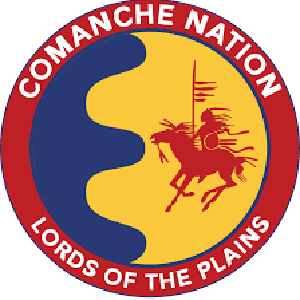Comanche Nation
By Wendy Weitzel

Rita Coosewoon, 87, was reminiscing about her childhood spent in the Fort Sill Indian School when she stopped herself mid-sentence, grasping for a word.
“You’ll have to excuse me,” she said with a smile that never reached her eyes.
“My brain still thinks in Comanche, and sometimes the English translation just can’t do it justice.”
A prominent tribal judge, Coosewoon wears many hats in the Comanche Nation, but as one of the few fluent Comanche speakers, she considers herself to be, above all else, a linguist.
That expertise in her first language has not been easy to maintain.
Coosewoon couldn’t recall exactly which of her relatives dropped her off at the boarding school as a young child, but she remembers the moment as being the greatest threat she faced in preserving her mother tongue and culture.
At Fort Sill Indian School, native languages were banned. Those who spoke them risked severe punishment, and Coosewoon often found herself among the disciplined students.
“I don’t know if it’s my stubbornness or by the grace of God that I remember the things that I remember,” she said. “ I know I shouldn’t remember, but I am so thankful that I do.”
She said she watched as her peers slowly conceded pieces of their Native cultures. Most had forgotten the Comanche language by the time they left the school, if they had ever known it at all, she said.
Coosewoon’s class was not the first to be educated at the school. Many of her peers’ parents, who had been disciplined there before her, had never taught their children to speak Native languages out of fear of the repercussions.
The trauma of re-education, she explained, had been passed down for generations.
Her granddaughter, Martina Minthorn, reached out to put a hand on her shoulder, and they shared an unspoken understanding. A tribal historic preservation officer, Minthorn explained that in her line of work, stories like her grandmother’s are common.
“Education for extinction is not something that started with Grandma Rita,” she said. “It’s been happening to our people since we were first confined to Oklahoma. It’s been happening to our people since before then.”
Even the name “Comanche” itself is a marker of European intervention, given to the tribe by the Spanish authorities in New Mexico. The word is a variation of “Kimantsi,” a Ute Indian word, and, while its exact meaning is debated, it is commonly thought to translate to “enemy.” Today, the tribe uses the Comanche name alongside the name they have always given themselves – Nʉmʉnʉʉ, which means “people.”
Minthorn said the termination of the Comanche people’s nomadic lifestyle came with the signing of the Medicine Lodge Peace Treaty in 1867. Before then, the tribe, which divided itself into bands, spanned the majority of the Great Plains and migrated to follow buffalo herds.
Having to abandon their way of life was detrimental to their culture and language.
“We didn’t give it up slowly, over time,” Minthorn said. “It happened immediately. It happened because it was forced to happen. We had Fort Sill right here in our backyard.”
Fort Sill was built in 1864 – just north of what would become Comanche Nation lands.
The Army base would implement many structures that would target Native culture, including the boarding school and a prison called the Ice House.
At the Ice House, Minthorn said, Comanches were incarcerated and mistreated for refusing the restraints placed on them by military supervision. The ruins are on an unmarked site within the boundaries of the Army post where field artillery soldiers are trained today.
Minthorn is working with elders in her community to have a sign placed on the site marking its significance and speaking to its present-day implications.
At 40 years old, her efforts are turning heads.
“Many people like to think that the Comanches died with my generation,” she said. “They really like to think of us as past tense, but it is our job – the young people – to show them exactly how resilient our people are.”
Wendy Weitzel is a reporter with Gaylord News, a reporting project at the University of Oklahoma Gaylord College of Journalism and Mass Communication.

